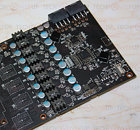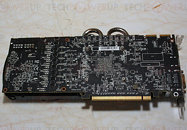Friday, January 13th 2012

PowerColor HD 7970 Vortex VRM: A Closer Look
On Thursday, we got to see the first images of PowerColor's new Radeon HD 7970 Vortex Edition graphics card. At CES we got to take a closer look at its VRM. PowerColor carried forward the VRM design of its Radeon HD 6970 Devil 13 graphics card. At the heart of the VRM is a CHiL CHL8228 VRM controller, which allows software volt-modding using most of the popular tools out there. The card uses an 8+1+1 phase VRM. It uses High Current Power Beat chokes which offers PWM frequency range of up to 3 MHz.
Interestingly, while the HD 6970 Devil 13 itself, like the Radeon HD 7970 AMD reference board, used expensive International Rectifier DirectFETs in typical configuration, the HD 7970 Votex uses cost-effective driver-MOSFET (DrMOS) chips that appear to be made by Renesas. Cost effective doesn't necessarily mean "cheap", these chips, according to PowerColor, offer 93% efficiency with up to 1 MHz switching frequency. On the reverse side of the PCB, we can find the power stage to be complemented with SP capacitors that offer 40% lower ESR with and support higher switching frequencies.This doesn't change our matter-of-fact observation from the older article that PowerColor used cost-effective components (compared to the CPL-made chokes and International Rectifier DirectFETs featured on AMD reference PCB), but that doesn't necessarily make it lower quality. AMD has a knack of going overkill with component quality on its reference boards that offer little real-world advantage over custom designs by AIBs, such as this card from PowerColor.
Interestingly, while the HD 6970 Devil 13 itself, like the Radeon HD 7970 AMD reference board, used expensive International Rectifier DirectFETs in typical configuration, the HD 7970 Votex uses cost-effective driver-MOSFET (DrMOS) chips that appear to be made by Renesas. Cost effective doesn't necessarily mean "cheap", these chips, according to PowerColor, offer 93% efficiency with up to 1 MHz switching frequency. On the reverse side of the PCB, we can find the power stage to be complemented with SP capacitors that offer 40% lower ESR with and support higher switching frequencies.This doesn't change our matter-of-fact observation from the older article that PowerColor used cost-effective components (compared to the CPL-made chokes and International Rectifier DirectFETs featured on AMD reference PCB), but that doesn't necessarily make it lower quality. AMD has a knack of going overkill with component quality on its reference boards that offer little real-world advantage over custom designs by AIBs, such as this card from PowerColor.


14 Comments on PowerColor HD 7970 Vortex VRM: A Closer Look
If that is a step down I wonder what is in the 7970...
IMO that is volterra VRM in the pic above, much different than that shown in the first picture. Volterra likes to advertise the need for little to no output caps other than a proadlizer or a bunch of ceramics like those shown.
What people don't understand is that DrMOS is a Driver and two MOSFETs. A power stage is a Driver and two MOSFETs. They are identical in theory. However Volterra power stages only will work with volterra PWMs(maybe a few other vendors who might be cool with the protocol) and the protocol is volterra. IR power stages like you can see on GB X79 boards used on the DRAm and VCCSA VRs with IR PWMs are a driver and two MOSFETs which work with IR protocols. DrMOS can come from a range of companies from renesas, to infeineon to vishay and work with a wide variety of PWMs, DrMOS is a standard but also a power stage.
What people don't understand is that some no names to board VRs like Ti makes the best digital PWMs, only followed by volterra then chil/ir. But Ti is also the most expensive digital PWM you can buy, followed by volterra who can't supply enough to asus and gb, then Chil only supplied to a few vendors and has exclusivity contracts, and then IR boguht them and increased options.
Volterra PWMs and their VRs look pretty sick tho, there is no denying it.
I think saying DrMOS is cost effective isn't the right way to say it, the only thing cost effective about them is that you can mix and match, and you also don't need to buy drivers made by the PWm company. Otherwise there are some very expensive DrMOS variants out there.
because of shortage of Ti DrMos...
We can reverse this by BoyCot. Hit these companies in the pocket book, and they will change there tune.
DirectFETs are usually used in either a typical 2 FET designs with a high-side(control) and low-side FET(sync), but the current runs through the sync FET to the inductor from the control FET. Now they have dual output sync-FETs, so you only need 3 MOSFETs with 1 driver for 2 phases. That it itself saves money on doublers and the extra FET, but also saves in efficiency. On some boards they use all 3 FETs in one phase on many they could use them and call them 2.
DrMOS are efficient because of less components, much increased power density is excellent. DrMOS are really powerstages, and no one calls volterra powerstages cost-effective. Volterra and IR and TI, and DrMOS makers all have the same concept of the driver and FETs integrated into one chip, but Voltera and Ti and IR have much different proprietary protocols. Volterra has a master/slave concept for instance. DrMOS really aren't that cheap they just don't shine really pretty and don't cool down as well as DirectFET/CopperMOS and probably can't handle as much beating.
the DirectFETs are much more durable in a way, and they are built for heavy duty applications, but they are also much easier to double to make larger phase systems. DrMOS require a PWm signal per phase, driver doublers seem to be much more common as now used on ASUS and GB motherboards. On older GB boards in which DrMOS were used they used different type of doubler than GB currently uses for the discrete FET designs. They both have their pros and cons. but IMO using DrMOS isn't bad, unless the DrMOS are known to have issues. Would i prefer DirectFETs? yes I would, but i wouldn't call them cost effective, that would be like calling all powerstages cost effective without knowing what kind of specs they have. They have Volterra and IR power stages that can output 40A and others that can do 60A, they have DrMOS that can do 50A and others that do 35A. Finding out the rating is important too.